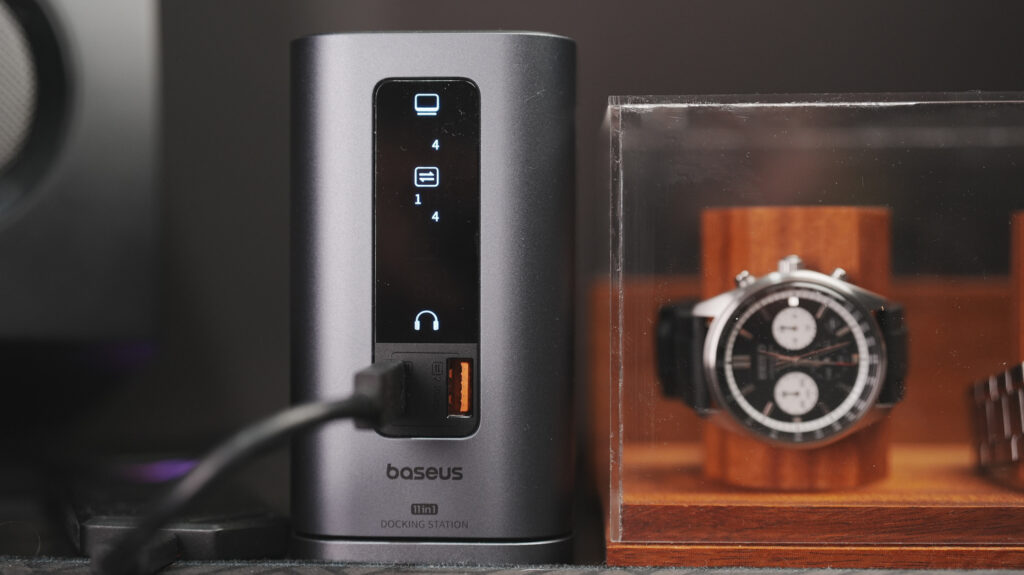As creative professionals, we strive to maintain a clutter-free workspace despite the extensive use of multiple editing tools. This review explores the Baseus 11-in-1 Spacemate Docking Station and its potential to minimize desk chaos while maximizing your photo editing efficiency.
A Glimpse of the Docking Station
Housed in grey aluminum, the compact Baseus Spacemate Docking Station – which is the size of a coffee cup and includes a firm, magnetically attached base – stays sturdy on your desk. This stability negates any disruptive motion while you work.
The front panel sports a digital LED-backlit display that keeps track of utilized ports and linked devices. Adjacent to this display are a 10 Gbps USB-C port and a 10 Gbps USB-A port, both facilitating high-speed connectivity with external storage devices.
The Pool of Ports
Turning the device over reveals a broad suite of ports. This set starts with a 100 W PD charging USB-C port and extends to incorporate another 10 Gbps USB-A port, a slower 480 Mbps USB-A port suitable for less vigorous wired or wireless accessories, and a 3.5 mm auxiliary port.
Additionally, the device flaunts two HDMI ports and a pair of DisplayPorts (each supporting up to 4K at 60 Hz). However, simultaneous usage is restrained to either two HDMI and one DP or two DP and one HDMI port. The built-in non-removable USB-C host cable grants easy connections with laptops or mobile devices.
Expanding Your Workspace
In an effort to promote efficient multitasking, the Baseus Docking Station syncs seamlessly with Windows to present four unique desktops. This feature allows you to efficiently spread your work across multiple screens.
Conversely, working on a Mac only yields two unique desktops. But rest assured, the quick shortcut button allows you to swiftly put your computers and displays to sleep, ensuring confidential information remains hidden from prying eyes.
Usage Summary
As a hub of connectivity, docking stations exist to amplify the capabilities of our computers. In fact, the Baseus Spacemate is adept at integrating all input-output devices into a single USB-C cable linked to the host computer. This integration facilitates the quick attachment of your laptop to a stable desktop setup, while also permitting up to three additional displays.
While the Baseus Spacemate does a competent job, it could benefit from more high-speed USB-C ports, given their universal applicability. Furthermore, including an SD and Micro SD card reader could potentially enhance its appeal to photographers.
Nonetheless, with its 10 Gbps ports, 4K display support, and handy indicator display, the Baseus Spacemate emerges as a useful tool to boost efficiency and keep digital clutter at bay.
Summing Up
The docking station serves to enhance your workstation productivity by expanding computer connectivity and helping maintain a neat, organized desk. Depending on your specific device requirements, the Baseus Spacemate might just be the efficient docking hub you need. While it does well in many areas, there are some improvements to be made, such as the inclusion of more high-speed USB-C ports and a built-in SD and Micro SD card reader.
Despite the potential for enhancement, this tool’s contribution to an efficient, tidy workspace cannot be overstated. Hence, before settling on a docking station, consider the Baseus Spacemate for its commendable features and future improvements.
